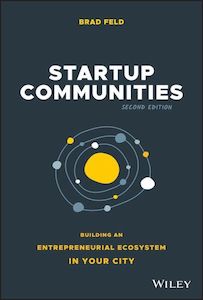Startup Communities is about the inspiring story and the message that you can build a vibrant startup ecosystem anywhere. If you can do it with a small 100 000 inhabitant city in Colorado it can be done elsewhere. Today, Boulder has one of the highest entrepreneurial densities in the world.
The author, Brad Feld, has been instrumental in the startup field globally for decades with Techstars, Startup Weekend, Startup Revolution book series, his blog Feld Thoughts and investment activities.
The book is based on the Boulder Thesis that are principles derived from practical experience and experimentation.
The first element is that the entrepreneurs must always lead the startup community. They are the role models and inspiration but also the driving force for community development. If entrepreneurs are not leading the community it will not be sustainable in the long-run.
The second key component is that the leaders must have a long-term commitment. A 20-year perspective is a long-enough time to think intra-generational and Feld updated this later to mean a rolling 20 years (20 years resets every day).
As a third component comes inclusivity, everybody needs to be welcome and new people should be included openly and actively to the ecosystem.
The final part of the thesis is the reminder to keep the full entrepreneurial stack engage continuously with activities.
There are factors that help startup ecosystems to grow. One of them is “external economies of scale” where the higher the density of startups the better the specialised services become and their average cost per startup goes down. Startup specialisation brings scale economies and more refined ecosystem that speeds up and helps to build new companies. Network effects bring similar advantages where a higher density of startups and successful entrepreneurs support the further growth and success of the ecosystem.
The startup ecosystem does not work only with entrepreneurs. There are other participants that are as valuable as entrepreneurs. They are called feeders, and influential community leaders that are not entrepreneurs are called instigators. As a network there is no hierarchy between the actors, they just have different roles.
For example, the government and public organisations are feeders that can help the ecosystem but they have different priorities, time perspectives and ways of operating. They tend to run with budgets (and easily measurable short-term results), political cycles and operate with a top-down approach.
Large companies can help the ecosystem at least in three ways. They can provide resources and infrastructure for the startup ecosystem, create startup programs, and naturally be customers of local startups.
The book is filled with practical advice and tips for all the participants ranging from give-first approach to experiment & fail fast, be mentorship-driven, play a positive-sum game among others.
One important aspect is the classical problems that tend to happen in ecosystems.
The patriarch problem describes the issue where the most powerful people in the top of the hierarchy try to control and be gatekeepers in the community. Feld gives two pieces of advice for tackling it. They are very simple and powerful: just ignore them and wait for them to leave the scene. No approval required, just start doing things.
Not enough capital is a favourite excuse for not doing enough. There are multiple ways to overcome this such as finding the capital where it is available or start local and then go big.
Another related issue is a reliance on government either with support or money. Often, the outcomes can fall short in both accounts, and in addition, public bodies are notoriously slow to take action if the results are not immediate they may soon move their focus elsewhere.
Other common issues are a culture of risk-aversion, avoiding people because of past failures, playing a zero-sum game, creation of artificial geographic boundaries or having a bias against newcomers.
It is no accident that some startup ecosystems thrive as the above demonstrates. It takes continuous effort by many people for extended periods of time. The impact that happens in a networked system is non-linear and it can be hard to time. Patience is required as well as the notion that you cannot control a startup community. It is a rapidly evolving and ever-changing organism that has the entrepreneurs in the middle and the rest of the participants supporting them. That’s why it’s called a startup community.

